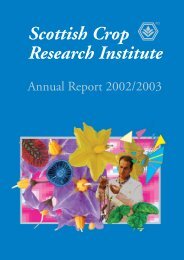SCRI Annual Report 2003/2004 - Scottish Crop Research Institute
SCRI Annual Report 2003/2004 - Scottish Crop Research Institute
SCRI Annual Report 2003/2004 - Scottish Crop Research Institute
Create successful ePaper yourself
Turn your PDF publications into a flip-book with our unique Google optimized e-Paper software.
Director’s <strong>Report</strong><br />
Direct and indirect energy consumption in agriculture<br />
for 2001, but not including the manufacture and distribution<br />
of food, was reckoned on ‘as supplied to agriculture’<br />
basis to be 183.1 PetaJoules (PJ) compared<br />
with 240.3 PJ in 1985. The 2001 figure represented<br />
only 0.3% of overall UK energy consumption. Energy<br />
was used directly for heating and motive power, and<br />
this amounted to 48.9 PetaJoules, with the bulk<br />
accounted for by petroleum and electricity (24.4PJ and<br />
16.5PJ, respectively). Indirect energy inputs were estimated<br />
at 134.2 PJ in 2001, representing fertiliser manufacture<br />
(94.6 PJ), animal feeds (20.7 PJ), tractor<br />
purchases (10.3 PJ), and pesticide manufacture (8.6<br />
PJ). The long-term trend of indirect energy usage<br />
since 1985 has been one of decline, with a questionable<br />
presumption by Government that adoption of<br />
organic production methods will further depress energy<br />
consumption. 2002-<strong>2003</strong>.<br />
Medicinal Plants The world has embarked on the<br />
‘knowledge economy’, a new educational and social<br />
phenomenon, raising the question as to the part to be<br />
played by countries that are not in the select group of<br />
‘leading’ economies. There is a danger that many<br />
countries will become increasingly sidelined from the<br />
benefits to be obtained from exploiting modern science,<br />
engineering, and a raft of new technologies.<br />
Consolidations, mergers, and strategic alliances are<br />
altering national and transnational trading arrangements.<br />
Huge flows of capital take place across borders,<br />
flows that dwarf the roles of bodies such as the World<br />
Bank and International Monetary Fund. The growing<br />
influence of such bodies as the World Trade<br />
Organisation demonstrate the inexorable rise of globalisation<br />
and international competition. The Internet is<br />
revolutionising the flow of information, scholarship,<br />
and the methods of trading. Importantly, intellectual<br />
property (IP) is tradable. There are huge opportunities<br />
arising from new areas of science, principally in information<br />
technology, computing, physics, chemistry,<br />
and biotechnology. Advances in molecular genetics<br />
have given rise to a plethora of new industries based on<br />
structural and functional genomics, proteomics,<br />
metabolomics, bioinformatics, diagnostics etc. which<br />
are collectively referred to as the ‘modern bioindustries’.<br />
A noteworthy development has been the formation<br />
of ‘industry clusters’ which comprise co-located<br />
universities, institutes, spin-out companies, serviceproviders,<br />
stockists, marketing and design companies,<br />
and related manufacturing companies.<br />
Drugs from plants represents an expanding area of<br />
human endeavour with widespread ramifications into<br />
public health policy, new approaches for pharmaceutical<br />
industries, the application of state-of-the-art technologies<br />
and manufacturing systems, novel intellectual<br />
property, access to traditional knowledge, exploitation<br />
of terrestrial and aquatic biodiversity, and policy issues<br />
on benefit-sharing.<br />
In Webster’s Third New International Dictionary<br />
(Merriam-Webster Inc. 1980), ‘drug’ is defined as (a) a<br />
substance used as a medicine, or for making medicines<br />
for internal or external use; (b) a substance recognised<br />
in an official pharmacopoeia or formulary; and (c) a<br />
substance used for the diagnosis, cure, mitigation,<br />
treatment, or prevention of disease. Drugs, therefore,<br />
include diagnostics and prophylactics. Biotechnology<br />
refers to the use of organisms, parts of organisms, or<br />
living processes for the needs of humans, an activity<br />
that is the most R&D-intensive industry in most of<br />
the advanced economies.<br />
Medicinal plants have and continue to be used directly<br />
or processed to (a) soothe and cure infections, diseases,<br />
and pain; (b) sedate, arouse, and hallucinate; (c) act as<br />
birth-control agents, purgatives and blood-pressure<br />
regulators; (d) control excretions and secretions. There<br />
is debate as to the extent to which modern medicine is<br />
based on drugs from plants consequent on the impact<br />
of synthetic chemistry. In the United States<br />
Pharmacopoeia, 70% of the listed drugs were plantderived<br />
whereas by 1936, 40% were plant-derived, a<br />
figure that has remained more or less constant,<br />
although several of the remaining 60% are conceptually<br />
based on plant-derived remedies. In addition, there<br />
is a rapidly growing over-the-counter market in nutritional<br />
supplements, most of which relate to traditional<br />
herbal medicines, and regulatory authorities worldwide<br />
are attempting to bring in quality-assurance measures,<br />
and seek validation of health-enhancing claims.<br />
In this ‘post-genomic era’, there is renewed interest in<br />
medicinal plants, as the pharmaceutical multinationals<br />
seek new approaches to generate new products, and<br />
governments become concerned over the massive<br />
growth in healthcare costs. As it is, around 80% of the<br />
global population is dependent on herbal medicine,<br />
based on traditional knowledge gleaned through generations<br />
of trial-and-error observations, word-of-mouth<br />
descriptions, and various types of record-keeping.<br />
Written records extend back to the Sumerian,<br />
Assyrian, Babylonian, Egyptian (e.g. the Ebers papyrus<br />
that details 850 plant medicines), Indian (e.g. Rig Veda<br />
that details 1500 plant medicines) and Chinese (e.g.<br />
Shen No(u)ng, the Yellow Emperor, Taoists) civilisa-<br />
91
















